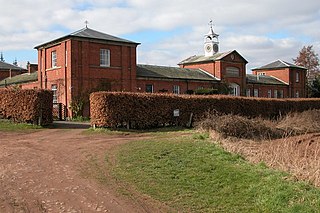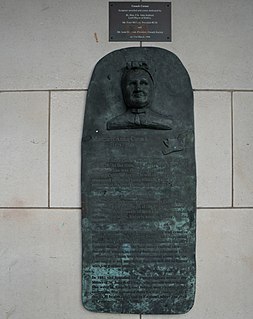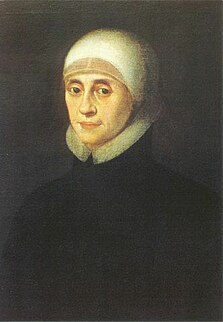
The Poor Clares, officially the Order of Saint Clare – originally referred to as the Order of Poor Ladies, and later the Clarisses, the Minoresses, the Franciscan Clarist Order, and the Second Order of Saint Francis – are members of a contemplative Order of nuns in the Catholic Church. The Poor Clares were the second Franciscan branch of the order to be established. Founded by Saints Clare of Assisi and Francis of Assisi on Palm Sunday in the year 1212, they were organized after the Order of Friars Minor, and before the Third Order of Saint Francis for the laity. As of 2011, there were over 20,000 Poor Clare nuns in over 75 countries throughout the world. They follow several different observances and are organized into federations.

Woodchester is a Gloucestershire village in the Nailsworth Valley, a valley in the South Cotswolds in England, running southwards from Stroud along the A46 road to Nailsworth. The parish population taken at the 2011 census was 1,206.

Agnes of Bohemia, O.S.C., also known as Agnes of Prague, was a medieval Bohemian princess who opted for a life of charity, mortification of the flesh and piety over a life of luxury and comfort. Although she was venerated soon after her death, Agnes was not beatified or canonized for over 700 years.

Catherine of Bologna [Caterina de' Vigri] was an Italian Poor Clare nun, writer, teacher, mystic, artist, and saint. The patron saint of artists and against temptations, Catherine de' Vigri was venerated for nearly three centuries in her native Bologna before being formally canonized in 1712 by Pope Clement XI. Her feast day is 9 March.

The Society of Saint Francis (SSF) is an international Franciscan religious order within the Anglican Communion. It is the main recognised Anglican Franciscan order, but there are also other Franciscan orders in the Anglican Communion.
The Third Order of Saint Francis is a third order in the Franciscan tradition of Christianity, founded by the medieval Italian Catholic friar Francis of Assisi.
The Community of St. Clare (OSC) is a Franciscan Anglican religious order of nuns, and part of the wider Franciscan movement within the Anglican Communion. The community, founded in 1950 and based at Freeland near Witney, Oxfordshire, England, is one of several associated with the Society of Saint Francis. It forms the 'Second Order' of the Anglican Franciscan movement, commonly known as the 'Poor Clares'. The community, in common with other Second Order Franciscan communities, is an enclosed and contemplative one, and the sisters provide for their own needs through a variety of activities. The sisters believe that their 'enclosed' life does not mean being 'shut in', but rather an opportunity to live and work together on one site in real community. The community runs a guest house and retreat centre, and the sisters engage in various works including sewing, painting, printing, and manufacturing altar breads.

The Capuchin Poor Clares is a religious order founded in Naples, Italy, in 1538, by Ven. Maria Laurentia Longo. The order still exists and it now has groups in the United States. Members are referred to as Capuchinesses.

The Convent of the Institute of the Blessed Virgin at Micklegate Bar, York, better known as TheBar Convent Living Heritage Centre, is the oldest surviving Catholic convent in England, established in 1686. The laws of England at this time prohibited the foundation of Catholic convents and as a result of this, the convent was both established and operated in secret. Frances Bedingfeld, a member of the Sisters of Loreto, signed the deeds for the land the convent was to be built upon on 5 November 1686 under the alias Frances Long.

Margaret Anna Cusack, also known as Sister Mary Francis Cusack and Mother Margaret, was first an Irish Anglican nun, then a Roman Catholic nun, then a religious sister and the founder of the Sisters of St. Joseph of Peace, and then an Anglican. By 1870 more than 200,000 copies of her works which ranged from biographies of saints to pamphlets on social issues had circulated throughout the world, the proceeds from which went towards victims of the Famine of 1879 and helping to feed the poor.

Clare of Assisi was an Italian saint and one of the first followers of Francis of Assisi. She founded the Order of Poor Ladies, a monastic religious order for women in the Franciscan tradition, and wrote their Rule of Life, the first set of monastic guidelines known to have been written by a woman. Following her death, the order she founded was renamed in her honour as the Order of Saint Clare, commonly referred to today as the Poor Clares. Her feast day is on 11 August.

The Convent of Poor Clares at Gravelines in the Spanish Netherlands, now northern France, was a community of English nuns of the Order of St. Clare, commonly called "Poor Clares", which was founded in 1607 by Mary Ward. The order of Poor Clares was founded in 1212 by Saint Clare of Assisi as the Second Order of the Franciscan movement. It is an enclosed religious order which follows an austere lifestyle. After the Reformation and its consequence, the Dissolution of the Monasteries between 1536 and 1541 by Henry VIII, the only opportunity for recusant English women to enter religious life was to leave the country and join a community overseas.
The Missionary Sisters of the Immaculate Conception of the Mother of God are an institute of religious sisters in the Catholic Church belonging to the Third Order Regular of St. Francis. They were founded in 1910 in Santarém, Brazil, by the Rt. Rev. Armand August Bahlmann, O.F.M., and Mother Immaculata, both natives of Germany, to educate the children of the poor throughout the world.

Former religious orders in the churches of the Anglican Communion are those communities of monks, nuns, friars, or sisters, having a common life and rule under vows, whose work has ended and whose community has been disbanded. In a very few cases this is due to the termination of the work for which the community was established, but in most cases it is due to amalgamation or the death of the final remaining member of the community.
Mary Ignatius Hayes, O.S.F., also known as Mother Mary Ignatius of Jesus, was an Anglican religious sister who was later received into the Catholic Church and became a Franciscan sister. Her lifetime of religious service, in the course of which she traveled widely, led to the establishment of three separate religious congregations of Franciscan sisters and the establishment of the Poor Clare nuns in the United States.

St Joseph's Convent is a complex of 18th- and 19th-century buildings in Taunton, Somerset, which were primarily used as a Roman Catholic convent, first by the Franciscans, and then Sisters of St. Joseph of Annecy. The buildings were sold out of the Catholic church in 1976, and were redeveloped as residential flats in 2005. The main building is designated by English Heritage as a Grade II* listed building, while the boundary walls on the west side are Grade II listed.

The Convento de Santa Clara la Real is a convent of the Poor Clares located in the city of Toledo, Castile-La Mancha, Spain. The present convent was founded in the middle of the 14th century by Toledan noblewoman María Meléndez, and is located near other monasteries of note, such as the monastery of Santo Domingo el Real and the Convent of Capuchins of Toledo.

The Abbey of the Minoresses of St. Clare without Aldgate known also variously as the "Abbey of the Blessed Virgin Mary, Aldgate" or the "House of Minoresses of the Order of St Clare of the Grace of the Blessed Virgin Mary" or the "Minoresses without Aldgate" or "St Clare outside Aldgate" or the "Minories, London" was a monastery of Franciscan women living an enclosed life, established in the late 13th century on a site often said to be of five acres, though it may have been as little as half that, at the spot in the parish of St. Botolph, outside the medieval walls of the City of London at Aldgate that later, by a corruption of the term minoresses, became known as The Minories, a placename found also in other English towns including Birmingham, Colchester, Newcastle upon Tyne and Stratford-upon-Avon.
The Monastery Saint Claire, also known as the Convent of Mary's Fear and by other names, is a convent of the Poor Clares on Tremor Hill in southern Nazareth, Israel.
















